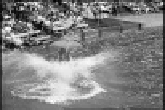Cryptography Reference
In-Depth Information
Motion-Adaptive Method: The WMs were embedded using the procedure de-
scribed in Sect. 7.3.3 with embedding bit b =1.
Conventional Method: The watermarking procedures were identical except
that s
i,j
was used in Step E4 instead of r
i,j
. The embedding quantity for
each frame was the same for both methods. The difference between r
i,j
and s
i,j
resulted in different distributions of the WMs among the pixels.
We selected five standard motion pictures based on the Degree of Object
Movement between frames and the Degree of Object Deformation between
frames (see Fig. 7.6):
(a) Walk through the Square (Walk): People walking in a town square
medium movement and medium deformation.
(b) Flamingos: Pan-scanned scene of flamingos much movement and
little deformation.
(c) Whale Show (Whale): Spraying whale with audience little move-
ment and much deformation.
(d) Entrance Hall (Hall): Three people talking in an entrance hall
little movement and little deformation.
(e) Rustling Leaves (Leaves):
Fluttering leaves much movement and
much deformation.
The pictures were subjectively evaluated using the procedure described in
Recommendation ITU-R BT.500-7 [16]. The original and watermarked pic-
tures after MPEG-2 encoding were simultaneously shown to ten evaluators.
They rated the picture quality based on the scale shown in Table 7.2. For each
picture, the average of the ten scores was used to determine the quality level.
(a) Walk
(b) Flamingos
(c) Whale
(d) Hall
(e) Leaves
Fig. 7.6.
Pictures evaluated.





